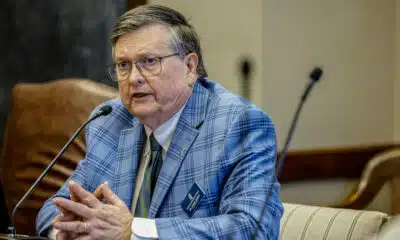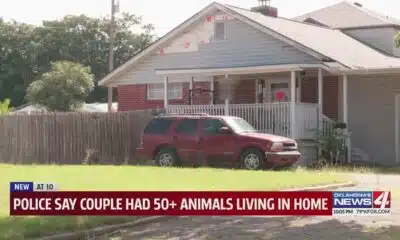Kaiser Health News
Epidemic: Do You Know Dutta?
by
Tue, 01 Aug 2023 09:00:00 +0000
By the mid-1970s, India’s smallpox eradication campaign had been grinding for over a decade. But the virus was still spreading beyond control. It was time to take a new, more targeted approach.
This strategy was called “search and containment.” Teams of eradication workers visited communities across India to track down active cases of smallpox. Whenever they found a case, health workers would isolate the infected person then vaccinate anyone that individual might have come in contact with.
Search and containment looked great on paper. Implementing it on the ground took the leadership of someone who knew the ins and outs of public health in India.
Episode 2 of “Eradicating Smallpox” tells the story of Mahendra Dutta, an Indian physician and public health worker who used his political savvy and local knowledge to pave the way to eradication. Dutta’s contributions were vital to the eradication campaign, but his story has rarely been told outside India. To conclude the episode, host Céline Gounder and epidemiologist Madhukar Pai discuss “decolonizing public health,” a movement to put leaders from the most affected communities in the driver’s seat to make decisions about global health.
The Host:
Céline Gounder
Senior fellow & editor-at-large for public health, KFF Health News
Céline is senior fellow and editor-at-large for public health with KFF Health News. She is an infectious diseases physician and epidemiologist. She was an assistant commissioner of health in New York City. Between 1998 and 2012, she studied tuberculosis and HIV in South Africa, Lesotho, Malawi, Ethiopia, and Brazil. Gounder also served on the Biden-Harris Transition COVID-19 Advisory Board.
In Conversation With Céline Gounder:
Madhukar Pai
Community medicine physician, professor of epidemiology and global health at McGill University in Montreal
Voices From the Episode:
Bill Foege
Smallpox eradication worker, former director of the Centers for Disease Control and Prevention
Yogesh Parashar
Pediatrician living in Delhi
Mahendra Dutta
Smallpox eradication worker, former health commissioner of New Delhi, India
Click to open the transcript
Transcript: Do You Know Dutta?
Podcast Transcript Epidemic: “Eradicating Smallpox” Season 2, Episode 2: Do You Know Dutta? Air date: Aug. 1, 2023
Editor’s note: If you are able, we encourage you to listen to the audio of “Epidemic,” which includes emotion and emphasis not found in the transcript. This transcript, generated using transcription software, has been edited for style and clarity. Please use the transcript as a tool but check the corresponding audio before quoting the podcast.
TRANSCRIPT
Céline Gounder:
This season, the “Epidemic” podcast is about the eradication of smallpox in South Asia. And to understand the breakout public health strategy that ultimately made eradication possible, we’re taking a quick detour … to West Africa.
[Nigerian music begins to play.]
Céline Gounder: It was 1966 — and Bill Foege found himself in Nigeria. The young physician and epidemiologist from Iowa was a long way from home — but in good company as part of a team of health workers sent to the region by the CDC [the Centers for Disease Control and Prevention]. Their mission was to vaccinate as many people as possible to stop smallpox.
They traveled from one remote location to the next on electric bikes. [Electric bikes whir.] To coordinate the work and respond quickly to each new outbreak, they had two-way radios. [Radio static crackles.]
[Music fades to silence.]
Bill Foege: On Dec. 4, 1966, I got a message saying, “I think we have smallpox. Could you come and look?”
We went to the place, 8 miles off of a road, and it was immediately clear that the first person I saw had smallpox. And so, we started looking at: What did we have in the way of vaccine?
Ordinarily, you would’ve done a mass vaccination campaign around the area.
Céline Gounder: At the time, the standard procedure was to vaccinate every single person in the region. But there was a problem: There wasn’t enough vaccine. Bill was still waiting on a big shipment. Without enough doses to vaccinate everyone, his team had to break protocol and get creative.
Bill Foege: We knew what we should do, but we couldn’t. So, at 7 o’clock that night, with maps in front of me, I divided the area and sent runners to the villages to see if they had smallpox. Twenty-four hours later, we got back on the radio [radio static], and now I could pinpoint the exact villages where there was smallpox. And we used the rest of our vaccine on those areas.
[Music begins.]
Bill Foege: Much to our surprise, smallpox simply stopped in weeks. We just were so fortunate — so lucky that with our limited vaccine, we were able to hit the right people. And by July, we were working on the last outbreak in all of eastern Nigeria.
Céline Gounder: The health workers began to wonder: Could this approach also work in other parts of the world? The new vaccine strategy — the innovation that Bill and his team stumbled upon, out of necessity — came to be known as “search and containment.”
That meant …
First searching for anyone with an active case of smallpox.
Then isolating the infected person.
And finally, tracking down and vaccinating everyone that person had come into contact with.
It worked in West Africa. Could it work in South Asia?
[Music fades to silence.]
Céline Gounder: Getting locals there to adopt search and containment was going to take an ally, a leader with a big personality who knew the ins and outs of public health in India. Someone who could make things happen. Someone whose story you’ve probably never heard.
Yogesh Parashar: Things look very rosy and very nice in a textbook. You never get the feel of what actually happened, how much sweat it entailed, what blood it entailed.
Céline Gounder: I’m Dr. Céline Gounder and this is “Epidemic.”
[“Epidemic” theme music plays then fades to silence.]
[Music begins.]
Céline Gounder: By 1973, countries from Nigeria to Brazil to Indonesia had recorded their final cases of smallpox. But in India, the campaign to end the disease was still grinding along. The population was roughly 600 million people — and the goal to vaccinate every single person in the country was daunting.
Epidemiologist Bill Foege was older now — in his late 30s — and leading the CDC’s global program to eradicate smallpox.
He turned his attention to Bihar, a state in eastern India. It was the biggest smallpox hot spot in the world. There, Bill found an ally and a good friend in another physician, a man named Mahendra Dutta. Mahendra was in charge of the smallpox eradication program in Bihar.
[Music fades to silence.]
Yogesh Parashar: He had a booming, loud voice.
Céline Gounder: That’s his son Yogesh Parashar, a pediatrician living in Delhi.
Yogesh Parashar: My father was known for his honesty. He would help people. He had that nature.
Céline Gounder: Mahendra Dutta died a few years ago. And Yogesh was just a boy during the eradication campaign. But his father shared stories from his years in the trenches fighting smallpox. And there was no battle bigger — or more lifesaving — than persuading the vaccinators to change their way of doing things.
After a decade of mass vaccination, smallpox raged on. Yogesh says his father could see that the strategy wasn’t working quickly enough to stop the virus.
Yogesh Parashar: The standard way of doing things is not going to get us anywhere. Being nice, doing the right way, is not going to get the disease away.
Céline Gounder: It was time to try something new. But getting India to adopt search and containment would prove challenging.
Yogesh Parashar: People who were trained in the previous school of thought could never believe that smallpox could be got rid of in this strategy.
Céline Gounder: Luckily, Mahendra could be very persuasive.
Yogesh Parashar: My father did all the dirty work. He got enemies also in the process, I’m sure he did, but that is what he did.
[Music begins.]
Céline Gounder: Mahendra Dutta was a gifted political strategist who built relationships with magistrates and commissioners throughout his work in public health. He was an insider who moved comfortably through the halls of power in India.
Once, over dinner and a glass of whisky — Chivas Regal, to be specific — a senior official told Mahendra to come to him in the future if he ever needed a favor. Later, when it was time to build support for search and containment, Mahendra knew exactly how to cash in on that promise.
Yogesh Parashar: My father gifted him the Chivas Regal.
“Now do you remember? You had told me that if I need any help, I should come to you. And here I am asking for help now.” This is how he did it.
Céline Gounder: You might call it “Dutta diplomacy.”
[Music fades to silence.]
Céline Gounder: Using charm and his extensive personal network, Mahendra recruited a staff of workers dedicated to the new strategy of search and containment — instead of trying to change the minds of people invested in the old ways of doing things.
Yogesh Parashar: So, practically, a parallel health system was set up.
Céline Gounder: The stakes were high.
Yogesh Parashar: Any outbreak was an emergency, because if you don’t move within hours and contain it, you do not know how many contacts will be there, how much it would spread, and your work would increase exponentially.
[Suspenseful music begins.]
Céline Gounder: Instead of waiting for smallpox cases to be reported, the workers headed out into the community to look for them.
Bill Foege: At first, we went and we talked to the village headmen, the teachers, and some children. And gradually, we went from that to actually going house by house in every village.
Céline Gounder: But some cases were still falling through the cracks.
Bill Foege: And so, we developed secondary surveillance teams who would go around to the markets with a smallpox identification card.
Yogesh Parashar: There were WHO [World Health Organization] cards, which had photographs of cases of smallpox, their face, their body, and so on. So, the people would go out and ask the students, ask the people in the market, “Have you seen such a person with this kind of an illness?” This was one way of actively searching.
Céline Gounder: Everyone was willing to help.
Yogesh Parashar: The vehicle driver would also ask. Why would the foreign epidemiologist ask? The vehicle driver will talk in the local language: “OK, I’m looking for this.” They will tell him, “Yes, this is here.”
Céline Gounder: And, as soon as a case was identified, a team of containment workers would spring into action, isolating the patient, tracking down their recent contacts, and vaccinating anyone they could have transmitted the virus to.
[Suspenseful music fades to silence.]
Céline Gounder: By 1974, the scale of the smallpox surveillance operation was gigantic. Over 100 million households across India were visited every single month in the search for active cases. Over 130,000 field workers were mobilized.
Bill Foege: At that point, we were having 1,500 new cases of smallpox a day in Bihar.
Céline Gounder: To manage all these moving pieces, the workers documented their efforts meticulously.
Bill Foege: I mean, you can’t imagine the millions of forms that we had. We had forms for everything. Forms for the containment team, forms for the assessors, forms for the watch guards.
I often said, “We’ve just buried smallpox in forms.”
Céline Gounder: Search and containment was working in Bihar. Mahendra and Bill could finally see a path to eradication.
Then, they hit a very public stumbling block that threatened to derail their work.
[Sound of bomb exploding.] Céline Gounder: In May 1974, journalists from all over the world flooded into the country to cover a major news event.
Here are a few lines from a New York Times article from that time.
[Voice actor reading a headline from the May 20, 1974, edition of The New York Times. An audio filter gives it a grainy ’70s newscaster’s sound. Typewriter sound effects play.]
Newscaster: India conducted today her first successful test of a powerful nuclear device. The surprise announcement means that India is the sixth nation to have exploded a nuclear device.
Céline Gounder: The code name for the nuclear bomb test was Operation Smiling Buddha. And with it, the country joined a short list of superpowers. All eyes were on India.
[Dramatic music begins playing.]
Céline Gounder: And … those international journalists on the hunt for interesting things to report came across another big story: Smallpox cases appeared to be exploding.
Bill Foege: And then suddenly the newspaper articles come out saying, here’s India working on nuclear weapons and they can’t even control smallpox.
Céline Gounder: In actuality, the new search-and-containment strategy was just a lot better at uncovering cases of smallpox.
But those glaring headlines — accurate or not — put the eradication program in the spotlight.
[Dramatic music fades to silence.]
Céline Gounder: Indian health officials were worried. And they threatened to pull their support for search and containment.
The famous Dutta diplomacy was about to be put to the test …
Bill Foege: The minister of health for all of India came to Patna, and Mahendra Dutta went to the airport to meet him.
Yogesh Parashar: He said, “I have to address a meeting, and it would be difficult to talk to you separately. So why don’t you get into my car?”
Céline Gounder: During the ride, the minister of health told Mahendra that he was on his way to a press conference to announce that the smallpox program would switch back to the strategy of mass vaccination.
To Mahendra, giving up on search and containment meant giving up on their best shot at eradication.
Bill Foege: And that’s when Mahendra Dutta said, “Before you do that, you have one more thing to do.” And he said, “What’s that?” He said, “You have to fire me.”
Yogesh Parashar: My father tells the minister that “if we are going to follow vaccinating everyone, then I think I should give you my resignation.”
Bill Foege: And the minister was irate. He said, “Do you know who you’re talking to?” And he said, “I do. And that’s how important this is.”
Céline Gounder: Mahendra told him the latest figures. He explained how the team was finally slowing the virus — that things were coming under control.
And the health minister listened.
Yogesh Parashar: And, within a few minutes, when they had reached the venue, the health minister was addressing the other officials, and he said, “OK, we have a new strategy of search and containment, which is very successful, has been tried in a number of countries, and we will bring forward this strategy and get rid of the disease.”
[Triumphant music begins playing.]
Bill Foege: All he did was praise the smallpox workers for what they had done, never said a word about switching back to mass vaccination.
That’s how close we came, I think, to losing the program in India. And, of course, if we lost it in India, we lost it everyplace.
Céline Gounder: If India, with its population of over 600 million people, failed to stop smallpox, then the virus would have remained a threat to the entire world.
Yogesh Parashar: My father has done the dirty job of saying what is to be said and got away with it.
He diplomatically bought time, allowed the search and containment to go on and get “smallpox zero.”
[Triumphant music fades to silence.]
Céline Gounder: While some of his American collaborators have been celebrated around the world for their work to end smallpox, Mahendra Dutta’s story — and his contributions — aren’t well known outside of India.
But we managed to find this recording of his voice …
[Brief pause.]
Mahendra Dutta: In public health, community approach, your conviction, your devotion, and team effort, that’s what matters the most.
Céline Gounder: That’s Mahendra Dutta in 2008, when he was in his late 70s. He and Bill Foege sat down together to reminisce about the history of smallpox eradication as part of a CDC event.
The two old friends reflected on what they’d learned together.
Bill Foege: I think that’s the lesson of smallpox in India, that the team worked as a unit. It was a coalition in truth.
Mahendra Dutta: Devoted efforts, team efforts always matter in community health work.
[Music begins playing.] Céline Gounder: Search and containment was one of the public health innovations that made eradication possible — that, and the collaboration among international health workers and local public health leaders.
Here, we followed the story of Mahendra Dutta, but there were many names — thousands — working together toward a common goal.
[Music begins.]
Céline Gounder: I have a friend who thinks about that a lot. Madhukar Pai is a community medicine physician, an epidemiologist — and he teaches global health.
His big thing is he wants rich countries to stop trying to use their own lens to solve health problems around the world. He says that just doesn’t work.
He’s calling for a “radical shift.” But …
Madhu Pai: It is hard to give up on power and privilege. No powerful person wants to ever give it up.
Céline Gounder: More from Madhu after the break.
[Music fades to silence.]
Céline Gounder: Wiping out smallpox nearly 50 years ago required the skill of thousands of local people who are largely unrecognized in any history book — or podcast.
Putting locals in the driver’s seat is one part of a growing movement to “decolonize” public health.
That term might sound wonky. But Madhukar Pai, a professor of epidemiology and global health at McGill University [in Montreal], says decolonizing public health is exactly what’s needed to get to health equity around the world.
But Madhu is frankly pretty pessimistic about the current system.
Madhu Pai: I sometimes wonder how the hell did we eradicate smallpox. I mean, today, I don’t think we would have. Honestly, if there was a virus like smallpox today, there’s zero chance of eradicating it.
Céline Gounder: So what was it about smallpox eradication that allowed us to do it?
Madhu Pai: I think those were simpler days, right? And then WHO said, you know what? Let’s just get all together and just help end this disease. That collaboration was unprecedented in smallpox.
But I think it was, in the end, remarkable numbers of people, you know, essentially armies of community health workers, vaccinators, front-line staff, field workers. And that was a mobilization kind of an effort that I think we definitely tried to do during covid. But probably not as unified as we could have been.
Céline Gounder: We did try to do something like that. It was called COVAX.
It was an alphabet soup of international groups — from Gavi to the WHO — that wanted to pool buying power and scientific resources.
COVAX was an attempt to make sure that there was covid vaccine for the whole world.
So … why did COVAX fail?
Madhu Pai: First of all, I think COVAX was conceived by “global north” white people, and it was conceived with all good intent, but essentially the “global south” was left behind even in the design of COVAX. Now that in essence is global health, right? That is, privileged people in the global north are constantly making decisions, thinking that we know best.
Céline Gounder: In case our audience isn’t familiar with that term, when Madhu says “global north,” that’s a shorthand for talking about wealthy industrialized nations.
Madhu Pai: Relying on the global north time and time and time again is doomed as an idea because we’ve seen there is no end to our greed and myopia and self-centeredness.
Céline Gounder: What would that have looked like? Centering international efforts to provide vaccines to low-income countries?
Madhu Pai: To me, centering on them rather than us and saying, “What do you need from us to succeed in your plan?” Right? “How can we be allies to you?” We need to get behind that and respect the desires and the aspirations of global south countries.
If there is a new pandemic and there’s a new vaccine or medicine, that technology should be transferred very quickly.
That’s what allyship genuinely is about. And that’s what our country should have done. We could … should have been allies as countries, right? We should have given the vaccine recipe. We should have helped out way better with the vaccine donation — the opportunity of a lifetime to be good allies. But we left it on the table.
Céline Gounder: If you had to give a grade to our global health response to covid, what would it be and why?
Madhu Pai: I would probably give it a “D” because I think, as humankind, we genuinely failed. There’s no reason at all so many people should have died. That’s inexcusable. The fact that 2.3 billion people, mostly in low-income countries, middle-income countries have not received even one dose is a very telling statement on how this all unfolded. That’s political failure. It’s got nothing to do with science, technology, or availability, or money.
Céline Gounder: So let’s say another pandemic hits us tomorrow. How is that gonna play out, then?
Madhu Pai: Exactly like it played out in covid, I do not expect anything different, honestly. Which is bloody sad, really.
Céline Gounder: You said before that the big global health programs have good intentions. So, what should they be doing differently?
Madhu Pai: Global health, as you know, is full of these examples where the global north person always gets the, you know, the shining credit and the medal on the wall.
We need to kind of flip the switch and re-center global health away from this, what I call default settings in global health, to the front lines. Right? People on the ground. People who are Black, Indigenous. People who are in communities. People who are actually dealing with the disease burden. People who are dying of it, right? People who have actually lived experience of these diseases that we are talking about, right? Having them run it is the most radical way of reimagining and shifting power and global health.
Céline Gounder: As Madhu and I were talking, he reminded me about Bill Foege. He’s the American eradication worker from Iowa we already met in this episode. The one who worked closely with local partners like Mahendra Dutta.
But near the end … he stepped out of the spotlight.
I asked Bill about this:
Céline Gounder: You left India before smallpox was declared eradicated. And as I understand it, that was important to you to no longer be in the country at the time. Why is that?
Bill Foege: I had the feeling that it should be an Indian victory. That foreigners should be happy and pleased that they had a chance to be part of it but don’t get carried away with being celebrated.
Madhu Pai: People like Foege are the exception in global health and not the norm. Finding ways to completely disappear and then center on people who really matter, I think is a, is a great gift.
The ability to do Dr. Foege’s ego-suppression work, uh, allyship work, that’s where the next frontier lies. And I’m not sure if we are ready for it, right? Because it is hard to give up on power and privilege, right? No powerful person ever wants to give it up.
Céline Gounder: So if you had a call to arms to your colleagues about preparing for the next pandemic, what would you say?
Madhu Pai: Yeah, I would say, anything that is led by global south, anything that is led by communities, must be on top of the agenda because that is how this is all gonna work.
So I don’t think climate change, or conflicts, or covid will be magically solved by global north institutions or individuals. So, de-center, de-center, de-center away from us, and be good allies to the global south.
Everybody’s agreed that we gotta do better, you know, we’ve got to decolonize global health. But it isn’t meaningfully moving the needle in the right direction. Because when rubber hits the road, our allyship only goes so far as just talking about it, which is not allyship at all in the first place.
[“Epidemic” theme music begins playing.]
Next time on “Epidemic” …
Bhakti Dastane: We have to achieve “zeropox,” so it was our motto: “zeropox.”
CREDITS
Céline Gounder: “Eradicating Smallpox,” our latest season of “Epidemic,” is a co-production of KFF Health News and Just Human Productions.
Additional support provided by the Sloan Foundation.
This episode was produced by Taylor Cook, Zach Dyer, Jenny Gold, and me.
Our translator and local reporting partner in India was Swagata Yadavar.
Taunya English is our managing editor.
Oona Tempest is our graphics and photo editor.
The show was engineered by Justin Gerrish.
We had extra support from Viki Merrick.
Music in this episode is from the Blue Dot Sessions and Soundstripe.
Audio of Mahendra Dutta via the Global Health Chronicles recorded at the David J. Sencer CDC Museum at the U.S. Centers for Disease Control and Prevention.
We’re powered and distributed by Simplecast.
If you enjoyed the show, please tell a friend. And leave us a review on Apple Podcasts. It helps more people find the show.
Follow KFF Health News on Twitter, Instagram, and TikTok.
And find me on Twitter @celinegounder. On our socials, there’s more about the ideas we’re exploring on the podcasts.
And subscribe to our newsletters at KFFHealthNews.org so you’ll never miss what’s new and important in American health care, health policy, and public health news.
I’m Dr. Céline Gounder. Thanks for listening to “Epidemic.”
[“Epidemic” theme music fades to silence.]
Bill Foege: It was great to work with you then, and it’s great to hear you reminisce now.
Mahendra Dutta: I’m also pleased that I’d worked with you.
Credits
Taunya English
Managing editor
Taunya is senior editor for broadcast innovation with KFF Health News, where she leads enterprise audio projects.
Zach Dyer
Senior producer
Zach is senior producer for audio with KFF Health News, where he supervises all levels of podcast production.
Taylor Cook
Associate producer
Taylor is associate audio producer for Season 2 of “Epidemic.” She researches, writes, and fact-checks scripts for the podcast.
Oona Tempest
Photo editing, design, logo art
Oona is a digital producer and illustrator with KFF Health News. She researched, sourced, and curated the images for the season.
Additional Newsroom Support
Lydia Zuraw, digital producer Tarena Lofton, audience engagement producer Hannah Norman, visual producer and visual reporter Simone Popperl, broadcast editor Chaseedaw Giles, social media manager Mary Agnes Carey, partnerships editor Damon Darlin, executive editor Terry Byrne, copy chief Gabe Brison-Trezise, deputy copy chiefChris Lee, senior communications officer
Additional Reporting Support
Swagata Yadavar, translator and local reporting partner in IndiaRedwan Ahmed, translator and local reporting partner in Bangladesh
“Epidemic” is a co-production of KFF Health News and Just Human Productions.
To hear other KFF Health News podcasts, click here. Subscribe to “Epidemic” on Apple Podcasts, Spotify, Google Podcasts, Pocket Casts, or wherever you listen to podcasts.
Title: Epidemic: Do You Know Dutta?
Sourced From: kffhealthnews.org/news/podcast/epidemic-season-2-episode-2-do-you-know-dutta/
Published Date: Tue, 01 Aug 2023 09:00:00 +0000
Kaiser Health News
States Brace for Reversal of Obamacare Coverage Gains Under Trump’s Budget Bill
Shorter enrollment periods. More paperwork. Higher premiums. The sweeping tax and spending bill pushed by President Donald Trump includes provisions that would not only reshape people’s experience with the Affordable Care Act but, according to some policy analysts, also sharply undermine the gains in health insurance coverage associated with it.
The moves affect consumers and have particular resonance for the 19 states (plus Washington, D.C.) that run their own ACA exchanges.
Many of those states fear that the additional red tape — especially requirements that would end automatic reenrollment — would have an outsize impact on their policyholders. That’s because a greater percentage of people in those states use those rollovers versus shopping around each year, which is more commonly done by people in states that use the federal healthcare.gov marketplace.
“The federal marketplace always had a message of, ‘Come back in and shop,’ while the state-based markets, on average, have a message of, ‘Hey, here’s what you’re going to have next year, here’s what it will cost; if you like it, you don’t have to do anything,’” said Ellen Montz, who oversaw the federal ACA marketplace under the Biden administration as deputy administrator and director at the Center for Consumer Information and Insurance Oversight. She is now a managing director with the Manatt Health consulting group.
Millions — perhaps up to half of enrollees in some states — may lose or drop coverage as a result of that and other changes in the legislation combined with a new rule from the Trump administration and the likely expiration at year’s end of enhanced premium subsidies put in place during the covid-19 pandemic. Without an extension of those subsidies, which have been an important driver of Obamacare enrollment in recent years, premiums are expected to rise 75% on average next year. That’s starting to happen already, based on some early state rate requests for next year, which are hitting double digits.
“We estimate a minimum 30% enrollment loss, and, in the worst-case scenario, a 50% loss,” said Devon Trolley, executive director of Pennie, the ACA marketplace in Pennsylvania, which had 496,661 enrollees this year, a record.
Drops of that magnitude nationally, coupled with the expected loss of Medicaid coverage for millions more people under the legislation Trump calls the “One Big Beautiful Bill,” could undo inroads made in the nation’s uninsured rate, which dropped by about half from the time most of the ACA’s provisions went into effect in 2014, when it hovered around 14% to 15% of the population, to just over 8%, according to the most recent data.
Premiums would rise along with the uninsured rate, because older or sicker policyholders are more likely to try to jump enrollment hurdles, while those who rarely use coverage — and are thus less expensive — would not.
After a dramatic all-night session, House Republicans passed the bill, meeting the president’s July 4 deadline. Trump is expected to sign the measure on Independence Day. It would increase the federal deficit by trillions of dollars and cut spending on a variety of programs, including Medicaid and nutrition assistance, to partly offset the cost of extending tax cuts put in place during the first Trump administration.
The administration and its supporters say the GOP-backed changes to the ACA are needed to combat fraud. Democrats and ACA supporters see this effort as the latest in a long history of Republican efforts to weaken or repeal Obamacare. Among other things, the legislation would end several changes put in place by the Biden administration that were credited with making it easier to sign up, such as lengthening the annual open enrollment period and launching a special program for very low-income people that essentially allows them to sign up year-round.
In addition, automatic reenrollment, used by more than 10 million people for 2025 ACA coverage, would end in the 2028 sign-up season. Instead, consumers would have to update their information, starting in August each year, before the close of open enrollment, which would end Dec. 15, a month earlier than currently.
That’s a key change to combat rising enrollment fraud, said Brian Blase, president of the conservative Paragon Health Institute, because it gets at what he calls the Biden era’s “lax verification requirements.”
He blames automatic reenrollment, coupled with the availability of zero-premium plans for people with lower incomes that qualify them for large subsidies, for a sharp uptick in complaints from insurers, consumers, and brokers about fraudulent enrollments in 2023 and 2024. Those complaints centered on consumers’ being enrolled in an ACA plan, or switched from one to another, without authorization, often by commission-seeking brokers.
In testimony to Congress on June 25, Blase wrote that “this simple step will close a massive loophole and significantly reduce improper enrollment and spending.”
States that run their own marketplaces, however, saw few, if any, such problems, which were confined mainly to the 31 states using the federal healthcare.gov.
The state-run marketplaces credit their additional security measures and tighter control over broker access than healthcare.gov for the relative lack of problems.
“If you look at California and the other states that have expanded their Medicaid programs, you don’t see that kind of fraud problem,” said Jessica Altman, executive director of Covered California, the state’s Obamacare marketplace. “I don’t have a single case of a consumer calling Covered California saying, ‘I was enrolled without consent.’”
Such rollovers are common with other forms of health insurance, such as job-based coverage.
“By requiring everyone to come back in and provide additional information, and the fact that they can’t get a tax credit until they take this step, it is essentially making marketplace coverage the most difficult coverage to enroll in,” said Trolley at Pennie, 65% of whose policyholders were automatically reenrolled this year, according to KFF data. KFF is a health information nonprofit that includes KFF Health News.
Federal data shows about 22% of federal sign-ups in 2024 were automatic-reenrollments, versus 58% in state-based plans. Besides Pennsylvania, the states that saw such sign-ups for more than 60% of enrollees include California, New York, Georgia, New Jersey, and Virginia, according to KFF.
States do check income and other eligibility information for all enrollees — including those being automatically renewed, those signing up for the first time, and those enrolling outside the normal open enrollment period because they’ve experienced a loss of coverage or other life event or meet the rules for the low-income enrollment period.
“We have access to many data sources on the back end that we ping, to make sure nothing has changed. Most people sail through and are able to stay covered without taking any proactive step,” Altman said.
If flagged for mismatched data, applicants are asked for additional information. Under current law, “we have 90 days for them to have a tax credit while they submit paperwork,” Altman said.
That would change under the tax and spending plan before Congress, ending presumptive eligibility while a person submits the information.
A white paper written for Capital Policy Analytics, a Washington-based consultancy that specializes in economic analysis, concluded there appears to be little upside to the changes.
While “tighter verification can curb improper enrollments,” the additional paperwork, along with the expiration of higher premiums from the enhanced tax subsidies, “would push four to six million eligible people out of Marketplace plans, trading limited fraud savings for a surge in uninsurance,” wrote free market economists Ike Brannon and Anthony LoSasso.
“Insurers would be left with a smaller, sicker risk pool and heightened pricing uncertainty, making further premium increases and selective market exits [by insurers] likely,” they wrote.
KFF Health News is a national newsroom that produces in-depth journalism about health issues and is one of the core operating programs at KFF—an independent source of health policy research, polling, and journalism. Learn more about KFF.
USE OUR CONTENT
This story can be republished for free (details).
KFF Health News is a national newsroom that produces in-depth journalism about health issues and is one of the core operating programs at KFF—an independent source of health policy research, polling, and journalism. Learn more about KFF.
Subscribe to KFF Health News’ free Morning Briefing.
This article first appeared on KFF Health News and is republished here under a Creative Commons license.
The post States Brace for Reversal of Obamacare Coverage Gains Under Trump’s Budget Bill appeared first on kffhealthnews.org
Note: The following A.I. based commentary is not part of the original article, reproduced above, but is offered in the hopes that it will promote greater media literacy and critical thinking, by making any potential bias more visible to the reader –Staff Editor.
Political Bias Rating: Center-Left
This content presents a critique of Republican-led changes to the Affordable Care Act, emphasizing potential negative impacts such as increased premiums, reduced enrollment, and the erosion of coverage gains made under the ACA. It highlights the perspective of policy analysts and state officials who express concern over these measures, while also presenting conservative viewpoints, particularly those focusing on fraud reduction. Overall, the tone and framing lean toward protecting the ACA and its expansions, which traditionally aligns with Center-Left media analysis.
Kaiser Health News
Dual Threats From Trump and GOP Imperil Nursing Homes and Their Foreign-Born Workers
In a top-rated nursing home in Alexandria, Virginia, the Rev. Donald Goodness is cared for by nurses and aides from various parts of Africa. One of them, Jackline Conteh, a naturalized citizen and nurse assistant from Sierra Leone, bathes and helps dress him most days and vigilantly intercepts any meal headed his way that contains gluten, as Goodness has celiac disease.
“We are full of people who come from other countries,” Goodness, 92, said about Goodwin House Alexandria’s staff. Without them, the retired Episcopal priest said, “I would be, and my building would be, desolate.”
The long-term health care industry is facing a double whammy from President Donald Trump’s crackdown on immigrants and the GOP’s proposals to reduce Medicaid spending. The industry is highly dependent on foreign workers: More than 800,000 immigrants and naturalized citizens comprise 28% of direct care employees at home care agencies, nursing homes, assisted living facilities, and other long-term care companies.
But in January, the Trump administration rescinded former President Joe Biden’s 2021 policy that protected health care facilities from Immigration and Customs Enforcement raids. The administration’s broad immigration crackdown threatens to drastically reduce the number of current and future workers for the industry. “People may be here on a green card, and they are afraid ICE is going to show up,” said Katie Smith Sloan, president of LeadingAge, an association of nonprofits that care for older adults.
Existing staffing shortages and quality-of-care problems would be compounded by other policies pushed by Trump and the Republican-led Congress, according to nursing home officials, resident advocates, and academic experts. Federal spending cuts under negotiation may strip nursing homes of some of their largest revenue sources by limiting ways states leverage Medicaid money and making it harder for new nursing home residents to retroactively qualify for Medicaid. Care for 6 in 10 residents is paid for by Medicaid, the state-federal health program for poor or disabled Americans.
“We are facing the collision of two policies here that could further erode staffing in nursing homes and present health outcome challenges,” said Eric Roberts, an associate professor of internal medicine at the University of Pennsylvania.
The industry hasn’t recovered from covid-19, which killed more than 200,000 long-term care facility residents and workers and led to massive staff attrition and turnover. Nursing homes have struggled to replace licensed nurses, who can find better-paying jobs at hospitals and doctors’ offices, as well as nursing assistants, who can earn more working at big-box stores or fast-food joints. Quality issues that preceded the pandemic have expanded: The percentage of nursing homes that federal health inspectors cited for putting residents in jeopardy of immediate harm or death has risen alarmingly from 17% in 2015 to 28% in 2024.
In addition to seeking to reduce Medicaid spending, congressional Republicans have proposed shelving the biggest nursing home reform in decades: a Biden-era rule mandating minimum staffing levels that would require most of the nation’s nearly 15,000 nursing homes to hire more workers.
The long-term care industry expects demand for direct care workers to burgeon with an influx of aging baby boomers needing professional care. The Census Bureau has projected the number of people 65 and older would grow from 63 million this year to 82 million in 2050.
In an email, Vianca Rodriguez Feliciano, a spokesperson for the Department of Health and Human Services, said the agency “is committed to supporting a strong, stable long-term care workforce” and “continues to work with states and providers to ensure quality care for older adults and individuals with disabilities.” In a separate email, Tricia McLaughlin, a Department of Homeland Security spokesperson, said foreigners wanting to work as caregivers “need to do that by coming here the legal way” but did not address the effect on the long-term care workforce of deportations of classes of authorized immigrants.
Goodwin Living, a faith-based nonprofit, runs three retirement communities in northern Virginia for people who live independently, need a little assistance each day, have memory issues, or require the availability of around-the-clock nurses. It also operates a retirement community in Washington, D.C. Medicare rates Goodwin House Alexandria as one of the best-staffed nursing homes in the country. Forty percent of the organization’s 1,450 employees are foreign-born and are either seeking citizenship or are already naturalized, according to Lindsay Hutter, a Goodwin spokesperson.
“As an employer, we see they stay on with us, they have longer tenure, they are more committed to the organization,” said Rob Liebreich, Goodwin’s president and CEO.
Jackline Conteh spent much of her youth shuttling between Sierra Leone, Liberia, and Ghana to avoid wars and tribal conflicts. Her mother was killed by a stray bullet in her home country of Liberia, Conteh said. “She was sitting outside,” Conteh, 56, recalled in an interview.
Conteh was working as a nurse in a hospital in Sierra Leone in 2009 when she learned of a lottery for visas to come to the United States. She won, though she couldn’t afford to bring her husband and two children along at the time. After she got a nursing assistant certification, Goodwin hired her in 2012.
Conteh said taking care of elders is embedded in the culture of African families. When she was 9, she helped feed and dress her grandmother, a job that rotated among her and her sisters. She washed her father when he was dying of prostate cancer. Her husband joined her in the United States in 2017; she cares for him because he has heart failure.
“Nearly every one of us from Africa, we know how to care for older adults,” she said.
Her daughter is now in the United States, while her son is still in Africa. Conteh said she sends money to him, her mother-in-law, and one of her sisters.
In the nursing home where Goodness and 89 other residents live, Conteh helps with daily tasks like dressing and eating, checks residents’ skin for signs of swelling or sores, and tries to help them avoid falling or getting disoriented. Of 102 employees in the building, broken up into eight residential wings called “small houses” and a wing for memory care, at least 72 were born abroad, Hutter said.
Donald Goodness grew up in Rochester, New York, and spent 25 years as rector of The Church of the Ascension in New York City, retiring in 1997. He and his late wife moved to Alexandria to be closer to their daughter, and in 2011 they moved into independent living at the Goodwin House. In 2023 he moved into one of the skilled nursing small houses, where Conteh started caring for him.
“I have a bad leg and I can’t stand on it very much, or I’d fall over,” he said. “She’s in there at 7:30 in the morning, and she helps me bathe.” Goodness said Conteh is exacting about cleanliness and will tell the housekeepers if his room is not kept properly.
Conteh said Goodness was withdrawn when he first arrived. “He don’t want to come out, he want to eat in his room,” she said. “He don’t want to be with the other people in the dining room, so I start making friends with him.”
She showed him a photo of Sierra Leone on her phone and told him of the weather there. He told her about his work at the church and how his wife did laundry for the choir. The breakthrough, she said, came one day when he agreed to lunch with her in the dining room. Long out of his shell, Goodness now sits on the community’s resident council and enjoys distributing the mail to other residents on his floor.
“The people that work in my building become so important to us,” Goodness said.
While Trump’s 2024 election campaign focused on foreigners here without authorization, his administration has broadened to target those legally here, including refugees who fled countries beset by wars or natural disasters. This month, the Department of Homeland Security revoked the work permits for migrants and refugees from Cuba, Haiti, Nicaragua, and Venezuela who arrived under a Biden-era program.
“I’ve just spent my morning firing good, honest people because the federal government told us that we had to,” Rachel Blumberg, president of the Toby & Leon Cooperman Sinai Residences of Boca Raton, a Florida retirement community, said in a video posted on LinkedIn. “I am so sick of people saying that we are deporting people because they are criminals. Let me tell you, they are not all criminals.”
At Goodwin House, Conteh is fearful for her fellow immigrants. Foreign workers at Goodwin rarely talk about their backgrounds. “They’re scared,” she said. “Nobody trusts anybody.” Her neighbors in her apartment complex fled the U.S. in December and returned to Sierra Leone after Trump won the election, leaving their children with relatives.
“If all these people leave the United States, they go back to Africa or to their various countries, what will become of our residents?” Conteh asked. “What will become of our old people that we’re taking care of?”
KFF Health News is a national newsroom that produces in-depth journalism about health issues and is one of the core operating programs at KFF—an independent source of health policy research, polling, and journalism. Learn more about KFF.
Subscribe to KFF Health News’ free Morning Briefing.
This article first appeared on KFF Health News and is republished here under a Creative Commons license.
The post Dual Threats From Trump and GOP Imperil Nursing Homes and Their Foreign-Born Workers appeared first on kffhealthnews.org
Note: The following A.I. based commentary is not part of the original article, reproduced above, but is offered in the hopes that it will promote greater media literacy and critical thinking, by making any potential bias more visible to the reader –Staff Editor.
Political Bias Rating: Center-Left
This content primarily highlights concerns about the impact of restrictive immigration policies and Medicaid spending cuts proposed by the Trump administration and Republican lawmakers on the long-term care industry. It emphasizes the importance of immigrant workers in healthcare, the challenges that staffing shortages pose to patient care, and the potential negative effects of GOP policy proposals. The tone is critical of these policies while sympathetic toward immigrant workers and advocates for maintaining or increasing government support for healthcare funding. The framing aligns with a center-left perspective, focusing on social welfare, immigrant rights, and concern about the consequences of conservative economic and immigration policies without descending into partisan rhetoric.
Kaiser Health News
California’s Much-Touted IVF Law May Be Delayed Until 2026, Leaving Many in the Lurch
California lawmakers are poised to delay the state’s much-ballyhooed new law mandating in vitro fertilization insurance coverage for millions, set to take effect July 1. Gov. Gavin Newsom has asked lawmakers to push the implementation date to January 2026, leaving patients, insurers, and employers in limbo.
The law, SB 729, requires state-regulated health plans offered by large employers to cover infertility diagnosis and treatment, including IVF. Nine million people will qualify for coverage under the law. Advocates have praised the law as “a major win for Californians,” especially in making same-sex couples and aspiring single parents eligible, though cost concerns limited the mandate’s breadth.
People who had been planning fertility care based on the original timeline are now “left in a holding pattern facing more uncertainty, financial strain, and emotional distress,” Alise Powell, a director at Resolve: The National Infertility Association, said in a statement.
During IVF, a patient’s eggs are retrieved, combined with sperm in a lab, and then transferred to a person’s uterus. A single cycle can total around $25,000, out of reach for many. The California law requires insurers to cover up to three egg retrievals and an unlimited number of embryo transfers.
Not everyone’s coverage would be affected by the delay. Even if the law took effect July 1, it wouldn’t require IVF coverage to start until the month an employer’s contract renews with its insurer. Rachel Arrezola, a spokesperson for the California Department of Managed Health Care, said most of the employers subject to the law renew their contracts in January, so their employees would not be affected by a delay.
She declined to provide data on the percentage of eligible contracts that renew in July or later, which would mean those enrollees wouldn’t get IVF coverage until at least a full year from now, in July 2026 or later.
The proposed new implementation date comes amid heightened national attention on fertility coverage. California is now one of 15 states with an IVF mandate, and in February, President Donald Trump signed an executive order seeking policy recommendations to expand IVF access.
It’s the second time Newsom has asked lawmakers to delay the law. When the Democratic governor signed the bill in September, he asked the legislature to consider delaying implementation by six months. The reason, Newsom said then, was to allow time to reconcile differences between the bill and a broader effort by state regulators to include IVF and other fertility services as an essential health benefit, which would require the marketplace and other individual and small-group plans to provide the coverage.
Newsom spokesperson Elana Ross said the state needs more time to provide guidance to insurers on specific services not addressed in the law to ensure adequate and uniform coverage. Arrezola said embryo storage and donor eggs and sperm were examples of services requiring more guidance.
State Sen. Caroline Menjivar, a Democrat who authored the original IVF mandate, acknowledged a delay could frustrate people yearning to expand their families, but requested patience “a little longer so we can roll this out right.”
Sean Tipton, a lobbyist for the American Society for Reproductive Medicine, contended that the few remaining questions on the mandate did not warrant a long delay.
Lawmakers appear poised to advance the delay to a vote by both houses of the legislature, likely before the end of June. If a delay is approved and signed by the governor, the law would immediately be paused. If this does not happen before July 1, Arrezola said, the Department of Managed Health Care would enforce the mandate as it exists. All plans were required to submit compliance filings to the agency by March. Arrezola was unable to explain what would happen to IVF patients whose coverage had already begun if the delay passes after July 1.
The California Association of Health Plans, which opposed the mandate, declined to comment on where implementation efforts stand, although the group agrees that insurers need more guidance, spokesperson Mary Ellen Grant said.
Kaiser Permanente, the state’s largest insurer, has already sent employers information they can provide to their employees about the new benefit, company spokesperson Kathleen Chambers said. She added that eligible members whose plans renew on or after July 1 would have IVF coverage if implementation of the law is not delayed.
Employers and some fertility care providers appear to be grappling over the uncertainty of the law’s start date. Amy Donovan, a lawyer at insurance brokerage and consulting firm Keenan & Associates, said the firm has fielded many questions from employers about the possibility of delay. Reproductive Science Center and Shady Grove Fertility, major clinics serving different areas of California, posted on their websites that the IVF mandate had been delayed until January 2026, which is not yet the case. They did not respond to requests for comment.
Some infertility patients confused over whether and when they will be covered have run out of patience. Ana Rios and her wife, who live in the Central Valley, had been trying to have a baby for six years, dipping into savings for each failed treatment. Although she was “freaking thrilled” to learn about the new law last fall, Rios could not get clarity from her employer or health plan on whether she was eligible for the coverage and when it would go into effect, she said. The couple decided to go to Mexico to pursue cheaper treatment options.
“You think you finally have a helping hand,” Rios said of learning about the law and then, later, the requested delay. “You reach out, and they take it back.”
This article was produced by KFF Health News, which publishes California Healthline, an editorially independent service of the California Health Care Foundation.
KFF Health News is a national newsroom that produces in-depth journalism about health issues and is one of the core operating programs at KFF—an independent source of health policy research, polling, and journalism. Learn more about KFF.
USE OUR CONTENT
This story can be republished for free (details).
KFF Health News is a national newsroom that produces in-depth journalism about health issues and is one of the core operating programs at KFF—an independent source of health policy research, polling, and journalism. Learn more about KFF.
Subscribe to KFF Health News’ free Morning Briefing.
This article first appeared on KFF Health News and is republished here under a Creative Commons license.
The post California’s Much-Touted IVF Law May Be Delayed Until 2026, Leaving Many in the Lurch appeared first on kffhealthnews.org
Note: The following A.I. based commentary is not part of the original article, reproduced above, but is offered in the hopes that it will promote greater media literacy and critical thinking, by making any potential bias more visible to the reader –Staff Editor.
Political Bias Rating: Center-Left
This content is presented in a factual, balanced manner typical of center-left public policy reporting. It focuses on a progressive healthcare issue (mandated IVF insurance coverage) favorably highlighting benefits for diverse family structures and individuals, including same-sex couples and single parents, which often aligns with center-left values. At the same time, it includes perspectives from government officials, industry representatives, opponents, and patients, offering a nuanced view without overt ideological framing or partisan rhetoric. The emphasis on healthcare access, social equity, and patient impact situates the coverage within a center-left orientation.
-
News from the South - Tennessee News Feed5 days ago
Bread sold at Walmart, Kroger stores in TN, KY recalled over undeclared tree nut
-
News from the South - Arkansas News Feed7 days ago
Man shot and killed in Benton County, near Rogers
-
News from the South - Georgia News Feed1 day ago
Aiken County family fleeing to Mexico due to Trump immigration policies
-
News from the South - Alabama News Feed6 days ago
Girls Hold Lemonade Stand for St. Jude Hospital | July 12, 2025 | News 19 at 10 p.m. – Weekend
-
News from the South - Georgia News Feed7 days ago
Anti-ICE demonstrators march to Beaufort County Sheriff's Office
-
News from the South - Oklahoma News Feed7 days ago
Police say couple had 50+ animals living in home
-
Mississippi Today4 days ago
Coast judge upholds secrecy in politically charged case. Media appeals ruling.
-
Local News5 days ago
Oyster spawning begins as MDMR-USM Hatchery Program enters production phase using mobile hatchery














































